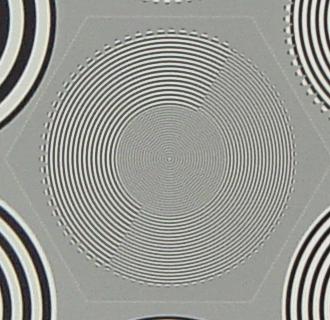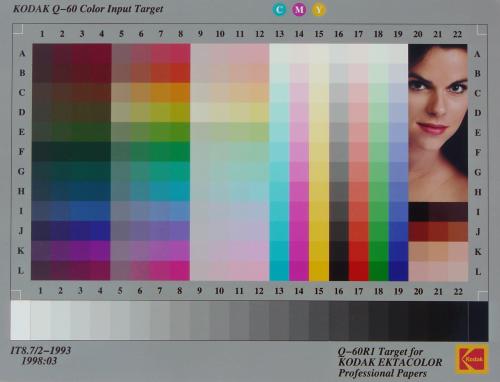|
|||||||
|
On the Bench All of these photos were taken outdoors in full sunlight, in AF Mode. Exposures averaged f/8 at 1/500th second. First, the Putora Sharpness Chart. Here is the photo of the entire chart, cropped and reduced in size for reproduction here. The image is somewhat soft in contrast.
Here is the resolution scale, cropped, but without reduction. The resolution begins to deteriorate at line series 8, which means that, for a distance of five feet and the lens set to its longest focal length of 21 mm, the lines per mm on this sensor, using this lens, is 45 lines. Note that this is the lines per mm for this lens-sensor combination. Although it is a higher number of lines than on the previous camera we reviewed, the Canon EOS-10D, the Canon has a larger lens and larger sensor. It also resolved up through line series 8, rather than line series 7 for the Sony.
Here is the series of center circles, cropped, but without reduction. The lines at 7 to 1 (clock numbers) are fine, but at 1 to 7, they are grayed out, and the center lines are almost completely gone.
Here is the gray scale portion of the Putora chart, reduced in size but otherwise unaltered. It is low contrast
I also tested the contrast with an Accu-Chart Gray Scale. Results are shown below, reduced in size. The whites are much closer to the original. Excellent!
Using the Gretag Macbeth Color Checker, the resulting image below has low contrast but is the correct tint, compared to the scanned standard in the second photo. White balance in Auto mode, is correct for these bright outdoor daylight conditions. The CD500 has the choice of ISO speeds 100, 200, and 400, other than "Auto". All digital cameras have increased noise as you increase the ISO. That is because the sensor has an optimum ISO setting, and increasing it reduces the exposure, which causes random colored pixels to show up in what is supposed to be the color of the object being photographed. It is like "pushing" the speed of film from its optimum of ISO 125 to ISO 1000, by developing it longer. This causes the film grain to increase. It is the same with digital sensors, but Sony has set the DV500's range very conservatively, so you probably won't get into trouble here.
The Kodak Q-60 Color Input Target. Again, it is low contrast, perhaps a bit underexposed, compared to the scanned standard in the second photo (made to look as close to the original as I could). Every step on the grayscale is distinguishable, so the photo can be manipulated in Photo Shop or Photo Impact to get a more pleasing image. The tint is accurate, including the skin tones.
Conclusions The Sony MVC-CD500 is an excellent performer, and it is something that previous Mavica fans would certainly enjoy, but also those camera fans who are looking for something a little different. For everyone else, Sony has lots of digital cameras that use their Memory Stick. We look forward to reviewing some of them soon.
- John E. Johnson, Jr. - Part I - Introduction and Features Part III - On the Bench and Conclusions
|
|||||||












